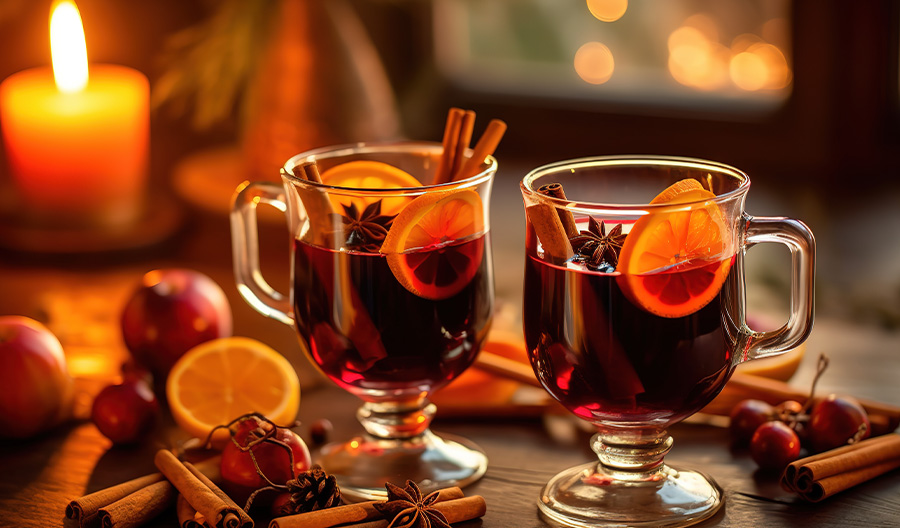There’s nothing quite like the spice-laden perfume of mulled wine warming on a stovetop. It’s an intoxicating scent that immediately rockets the mind to days spent bundled up outdoors, rollicking in the snow, only to come inside to warm up with a mugful of something warm and alcoholic.
It’s perhaps for this reason that mulled wine is especially popular during the winter holidays. Here’s everything you need to know about this cold-weather staple.
What Is Mulled Wine?
Mulled wine is a type of hot, boozy drink that is sweetened and spiced. To make it, wine is heated along with spices that commonly include cinnamon, allspice, ginger and black pepper.
Popular versions include glühwein, a traditional German variety; France’s vin chaud; and Norwegian gløgg, which features the country’s national spirit, aquavit.
The History of Mulled Wine
Mulled drinks date back to the first century, when a Roman gourmand Apicus wrote of ‘conditum paradoxum,’ a white wine with honey, saffron, mastica and black pepper.
Other medieval-era mulled drinks include Hippocras gyle, which was a spice mixture of galangal, cardamom, cinnamon, grains of paradise, cubebs and long pepper infused in wine.
The spices were filtered through a bag known to apothecaries as a manicum hippocraticum—the sleeve of Hippocrates, which gave the drink its name.

What Is the Best Wine for Mulled Wine?
Most mulled wines are traditionally made with reds, and the best red for mulled wine is fresh, dry, juicy and medium-bodied. Fruit-forward is key. Steer clear of oaky or overly tannic wines, which can turn bitter when heated. Light-bodied wines can get lost amid the intensity of mulling spices, while very jammy, full-bodied wines can become cloying.
You might be tempted to use big, “spicy” wines that reflect the ingredients that will be infused. But the spice and citrus added, not to mention sugar and brandy, will thwart any subtleties of a spicy wine.
Look instead for balance between the mulling ingredients and the wine’s fruitiness. Most wines will work, but try Grenache, Tempranillo, Valpolicella, Sangiovese, Merlot and warm-climate Pinot Noir that are unoaked, or aged in neutral oak.
How to Make Mulled Wine
Ingredients:
- 2 oranges
- 1 bottle of a fruit-forward red wine like Merlot or Grenache
- ¼ cup brandy
- 1 to 2 tablespoons sweetener, maple syrup or honey
- 2 whole cinnamon sticks
- 3 star anise
- 5 whole cloves
- Optional garnishes: Fresh whole cranberries (about ¼ cup), cinnamon sticks, additional orange rounds or half moons.
Instructions:
- Slice one orange into rounds and slice the other in half. Place the rounds into a medium heavy-bottomed pot or small Dutch oven. Squeeze the juice from the remaining oranges into the pot.
- Combine all ingredients into the pot except 1 tablespoon of the sweetener.
- Warm the mixture over medium heat until steaming (about 5 minutes) and keep an eye on it. When you start seeing the tiniest of bubbles at the surface, reduce the heat to the lowest of low.
- Carefully taste, and another tablespoon of sweetener, to taste.
- Continue cooking over very low heat for 5 to 10 more minutes.
- Serve in mugs with your desired garnishes! 1 Bottle wine serves 5 people.

